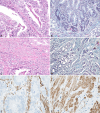Assessment of tumor microenvironment in gastric adenocarcinoma
- PMID: 37518883
- PMCID: PMC10520378
- DOI: 10.47162/RJME.64.2.16
Assessment of tumor microenvironment in gastric adenocarcinoma
Abstract
Gastric cancer (GC), despite the current possibilities of early diagnosis and curative treatment, remains a major public health problem, being one of the main causes of cancer, due to its detection in advanced stages. Screening programs applied in Western countries led to low incidence rates in these countries. Helicobacter pylori bacterial infection is considered to be the highest risk factor for the onset of GC because it causes chronic inflammation of the gastric mucosa and damages hydrochloric acid secretory glands, eventually leading to atrophic gastritis, which has a potential to progress to GC. In our study, we aimed at assessing the tumor microenvironment in gastric adenocarcinomas as approximately 90% of GCs are adenocarcinomas. Our study showed that the tumor microenvironment has an extremely complex morphological structure, totally different from the microscopic structure of the gastric wall, consisting of stromal cells, lymphocytes, plasma cells, macrophages, blood vessels, collagen fibers, extracellular connective matrix, other cells. The tumor microenvironment presents phenotypic, cellular and molecular heterogeneity; therefore, the microscopic aspect differs from one tumor to another and even from one region to another in the same tumor. Poorly or moderately differentiated adenocarcinomas show a more intense desmoplastic reaction than well-differentiated ones. Alpha-smooth muscle actin (α-SMA)-positive stromal cells (tumor-associated fibroblasts) and tumor macrophages were the most numerous cells of the tumor microenvironment. The tumor microenvironment is the result of cooperation between tumor cells, cancer-associated fibroblasts, immune system cells and blood vessels. It allows tumor cells to multiply, grow and metastasize.
Conflict of interest statement
The authors declare that they have no conflict of interests.
Figures













References
-
- Sung H, Ferlay J, Siegel RL, Laversanne M, Soerjomataram I, Jemal A, Bray F. Global Cancer Statistics 2020: GLOBOCAN estimates of incidence and mortality worldwide for 36 cancers in 185 countries. CA Cancer J Clin. 2021;71(3):209–249. - PubMed
-
- Forman D, Burley VJ. Gastric cancer: global pattern of the disease and an overview of environmental risk factors. Best Pract Res Clin Gastroenterol. 2006;20(4):633–649. - PubMed
-
- Ferlay J, Shin HR, Bray F, Forman D, Mathers C, Parkin DM. Estimates of worldwide burden of cancer in 2008: GLOBOCAN 2008. Int J Cancer. 2010;127(12):2893–2917. - PubMed
-
- Smyth EC, Nilsson M, Grabsch HI, van Grieken, Lordick F. Gastric cancer. Lancet. 2020;396(10251):635–648. - PubMed
MeSH terms
LinkOut - more resources
Full Text Sources
Medical
Miscellaneous

